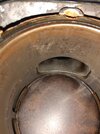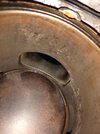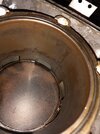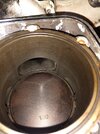WhiteZombie
Member
So I'm rebuilding the carbs on a 1998 Sportster with twin 717 engines. The needle valves on both would not hold the 10psi. One leaked down instantly, so I ordered new 1.5 gram needle kits per Seadoo manual specs. Got them and noticed that they were smaller than what is in the carbs. Mikinu documentation says that the 1.5 is plenty big for the carbs capabilities, and Seadoo info says pretty much same, but in overthinking that point I conclude that Seadoo is assuming the engines are bored to their specs which is 82.50 max bore. But still Mikinu says they are feeding the carb all the fuel it needs with that port size. Anyway upon seeing the change I decided to pop the tops off the engines to see what I have gotten myself into, as I was most likely going to anyway. I have checked the compression with a brand new gauge and found all cylinders to be hitting 150 psi by the third turn over, with each reading around 145psi on first turn.
So what I found and think I understand after reading numerous posts is that my piston has a 1.00 stamped on it and that is the biggest piston available to my understanding. I was a machinist by trade, so I measured the bore with a Mitutuyo caliper and a Starret bore micrometer, which is a bit challenging to get a good read on due to limited contact area. Basically 3 cylinders are bored at 83.08(3.271) and the third is coming in at 83.10(3.73ish). So around .001-.002 over the other bores. Seadoo says 82.50 (3.248") is max bore. Upon inspecting the larger bore, I noticed some pitting. Not very deep, can only feel with fingernail.
I'm attaching some photos. I would like to know what may have caused this pitting on this one cylinder if we can get an idea. I am also at a crossroad on it cause i've got a lot of time this spring spent on working on the boat to get it in the water. I don't know if I should just get it running to get in the water to see what it does and what else it may need with intentions of doing the work in the winter, or do I take these cans off and hone them and be done with it. I can't say it is getting any worse and have no idea how long they've been like this, but I'm guessing quite a while. I wonder if the piston had rusted in the cylinder and they freed it up and put it in. I do know this engine does have shims installed on the motor mounts so I assume it is a changeout of some type. Funny thing is this engine is the one that was running. I got both running before taking the carbs off.
Fortunately I do have a "mill drill" that I use for projects like this. I also have a small boring head so I can bore a couple thousandths out and then hone it if I have to, but idealy I would just get a good hone and do it all. I can make a jig to hold the can. And then the carb jets are a question too. I can't read the numbers on them, but the high jet is measuring around .071" with a dowel pin. I have no idea if these need rejeting or not due to the 50 over bore, but I do know the high jet adjustment was 1/4 turn on one and totally closed on the other, which after reading several posts is acceptable. The manual says 1/4 turn. The low jets were set at factory spec too pretty much, so basically I have a 50 over bore with not much carb adjustment unless they did rejet and wound up with same adjustments. Anyway, I'm too the point where i am getting past my knowledge on engine tuning, so I need some help. I can do the work, I just need to know what to do. I do have the service manual with addendum. I did not open the needle kits just in case I do need a 2 gram. I have been putting everything back to factory spec to this point. I hope I don't get into a jetting nightmare with these 50 over bored engines. One other thing is this engine does smoke, but I was thinking it to be a carb issue as the needle had a piece of the clumpy chalky fuel build up debris between it and the port, so it was flooding I would assume. Thanks for reading. I know this is a lot, but I'm just at that point of frustrating confusion. Thanks in advance!
So what I found and think I understand after reading numerous posts is that my piston has a 1.00 stamped on it and that is the biggest piston available to my understanding. I was a machinist by trade, so I measured the bore with a Mitutuyo caliper and a Starret bore micrometer, which is a bit challenging to get a good read on due to limited contact area. Basically 3 cylinders are bored at 83.08(3.271) and the third is coming in at 83.10(3.73ish). So around .001-.002 over the other bores. Seadoo says 82.50 (3.248") is max bore. Upon inspecting the larger bore, I noticed some pitting. Not very deep, can only feel with fingernail.
I'm attaching some photos. I would like to know what may have caused this pitting on this one cylinder if we can get an idea. I am also at a crossroad on it cause i've got a lot of time this spring spent on working on the boat to get it in the water. I don't know if I should just get it running to get in the water to see what it does and what else it may need with intentions of doing the work in the winter, or do I take these cans off and hone them and be done with it. I can't say it is getting any worse and have no idea how long they've been like this, but I'm guessing quite a while. I wonder if the piston had rusted in the cylinder and they freed it up and put it in. I do know this engine does have shims installed on the motor mounts so I assume it is a changeout of some type. Funny thing is this engine is the one that was running. I got both running before taking the carbs off.
Fortunately I do have a "mill drill" that I use for projects like this. I also have a small boring head so I can bore a couple thousandths out and then hone it if I have to, but idealy I would just get a good hone and do it all. I can make a jig to hold the can. And then the carb jets are a question too. I can't read the numbers on them, but the high jet is measuring around .071" with a dowel pin. I have no idea if these need rejeting or not due to the 50 over bore, but I do know the high jet adjustment was 1/4 turn on one and totally closed on the other, which after reading several posts is acceptable. The manual says 1/4 turn. The low jets were set at factory spec too pretty much, so basically I have a 50 over bore with not much carb adjustment unless they did rejet and wound up with same adjustments. Anyway, I'm too the point where i am getting past my knowledge on engine tuning, so I need some help. I can do the work, I just need to know what to do. I do have the service manual with addendum. I did not open the needle kits just in case I do need a 2 gram. I have been putting everything back to factory spec to this point. I hope I don't get into a jetting nightmare with these 50 over bored engines. One other thing is this engine does smoke, but I was thinking it to be a carb issue as the needle had a piece of the clumpy chalky fuel build up debris between it and the port, so it was flooding I would assume. Thanks for reading. I know this is a lot, but I'm just at that point of frustrating confusion. Thanks in advance!







